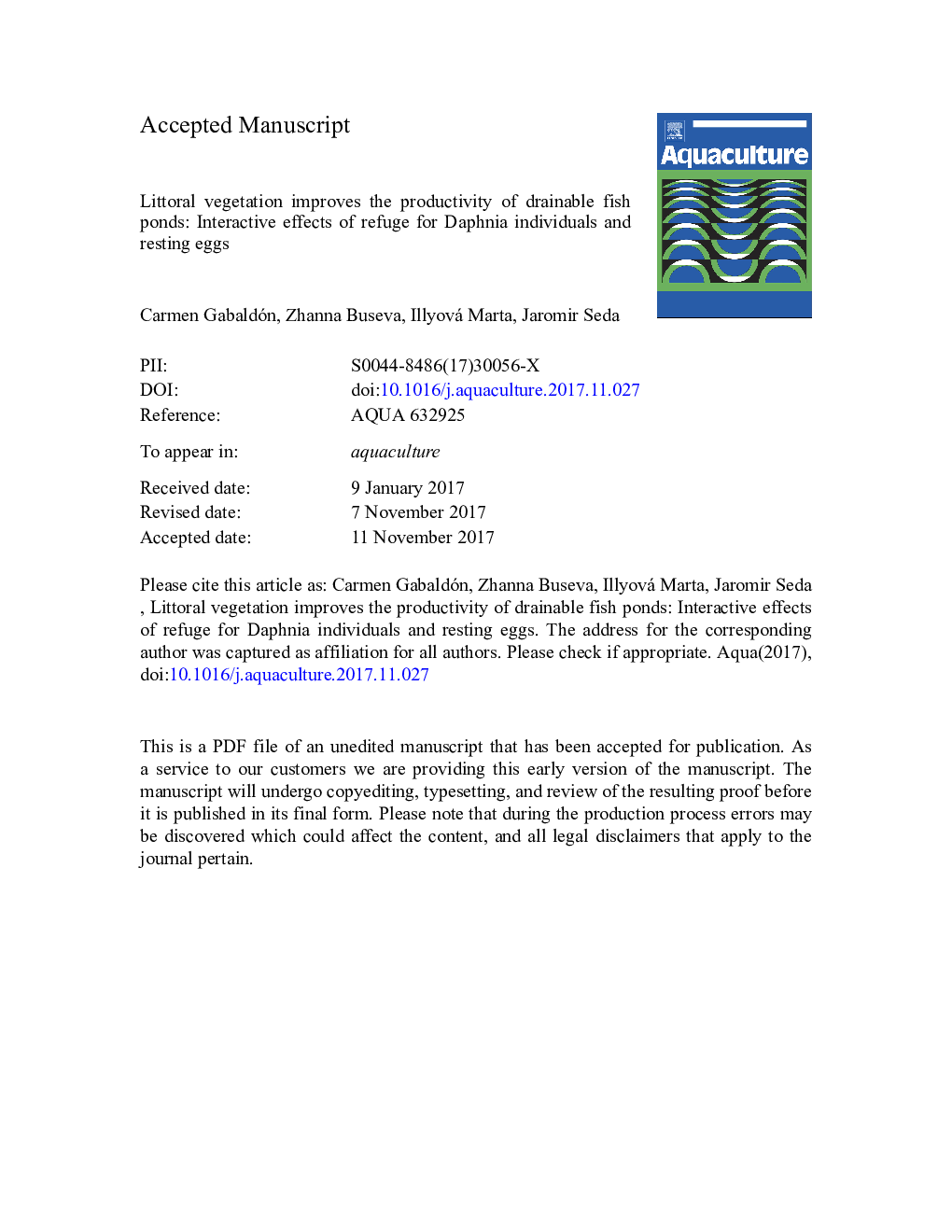| کد مقاله | کد نشریه | سال انتشار | مقاله انگلیسی | نسخه تمام متن |
|---|---|---|---|---|
| 8493522 | 1552803 | 2018 | 29 صفحه PDF | دانلود رایگان |
عنوان انگلیسی مقاله ISI
Littoral vegetation improves the productivity of drainable fish ponds: Interactive effects of refuge for Daphnia individuals and resting eggs
ترجمه فارسی عنوان
پوشش گیاهی ساحلی باعث افزایش بهره وری از حوضه ماهی های قابل تخلیه می شود: اثرات تعاملی پناه برای افراد دافنی و تخم مرغ های استراحت
دانلود مقاله + سفارش ترجمه
دانلود مقاله ISI انگلیسی
رایگان برای ایرانیان
کلمات کلیدی
موضوعات مرتبط
علوم زیستی و بیوفناوری
علوم کشاورزی و بیولوژیک
علوم آبزیان
چکیده انگلیسی
Management of fish pond farming involves diverse practises aimed at increasing fish productivity, such as polyculture stocks, supplementary artificial feeding, adding nutrients, or drying ponds during winter or summer. Since aquatic vegetation has a positive influence on fish richness and biomass, aquatic plants could also have a positive effect on the fish productivity; however, its role has received little attention. Here, we conducted a study in which the productivity of carp was recorded in two ponds, one vegetated and the other with scarce coverage of aquatic plants. During winter, the ponds are dried, and are filled up with water in the spring. Then two-year-old carps are introduced to allow their growth until autumn when the ponds are drained and the fish harvested. The water used to fill the ponds contains no zooplankton organisms, so crustacean populations appear in the water column through the growth of hatchlings from resting stages deposited in the pond sediment during previous seasons. In order to explain patterns in fish productivity, crustaceans, which constitute an important element in the fish diet, were investigated. Particularly, the dynamics of the crustacean species were estimated during the spring and summer and, since cladoceran species are one of the main preferred preys of carp, body and clutch sizes of Daphnia were measured. Moreover, the density of cladoceran resting eggs in the sediment was estimated after the dry pond was filled, and just before the next pond filling. We found differences between vegetated and non-vegetated ponds. In the pond with aquatic vegetation (1) fish productivity was higher, (2) Daphnia species started to grow significantly earlier, had higher relative abundances, and delayed the population decline, (3) large sized European Daphnia galeata dominated over small sized American Daphnia parvula and Daphnia ambigua, and (4) the cladoceran resting egg bank was less eroded during winter when the ponds were dried. The results of this study indicate that macrophytes are likely to operate as a protection mechanism, not only for individual Daphnia, which keeps higher population densities and larger body sizes despite fish predation, but also protects the resting egg bank. This, in turn, was positively related to carp biomass. Accordingly, we consider that increasing macrophyte coverage should be considered in the management strategies for carp pond farming since littoral plant vegetation may act as a refuge for cladocerans as well as a productive ecotone improving the productivity of fish ponds.
ناشر
Database: Elsevier - ScienceDirect (ساینس دایرکت)
Journal: Aquaculture - Volume 485, 2 February 2018, Pages 111-118
Journal: Aquaculture - Volume 485, 2 February 2018, Pages 111-118
نویسندگان
Carmen Gabaldón, Zhanna Buseva, Marta Illyová, Jaromir Seda,
